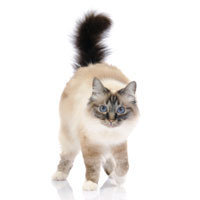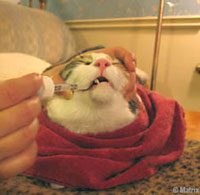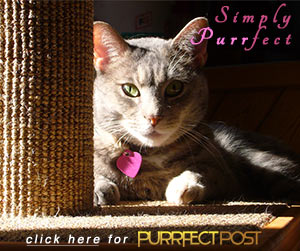How To Give Liquid Medications
 Prescribed medications frequently come in the form of liquid formulations. Many of these are designed to be given in the mouth ( PO , orally). To carry out this procedure, there are a few easy steps to follow:
Prescribed medications frequently come in the form of liquid formulations. Many of these are designed to be given in the mouth ( PO , orally). To carry out this procedure, there are a few easy steps to follow:
- Keep the medication at refrigerator temperature—this keeps the medicine fresh. The cool temperature of the liquid also helps Kitty feel the medicine in her mouth, which reduces the chance of choking or aspirating (inhaling into the lungs), which is a serious complication.
- Draw liquid into the measuring syringe up to the prescribed dose mark—use only the syringe dispensed. Substituting a household teaspoon or other measure may be a problem since it may not be calibrated precisely, and this may lead to dosage error.
- Remove any trapped air bubbles by tapping the syringe or dropper gently.
- Gently lift the head and steady it—make sure you do not ask her to swallow with her noise pointing directly at the ceiling—it is hard to swallow with an extremely extended head position.

- Place the syringe tip along the side of the mouth and dribble the medication in—do not shove the syringe tip down the throat.
- Squeeze the bulb slowly, or press the syringe plunger slowly to allow her time to swallow. This is especially important if a larger volume is being administered.
- After administration, steady the head in a slightly upward position with muzzle gently closed.
- Look for licking of the lips, or feel the neck for the swallowing movement.
- Then release her, and praise her.
Give all of the doses at the prescribed intervals. Any variation from the prescription could lead to side effects, or lack of beneficial effects. Overdosing can lead to toxicity. With antibiotics, missed or inappropriate dosing can lead to bacterial resistance, a serious problem for disease control in the wider community.
Make sure you have a safe restraint system in place. If you think that your cat might bite you, contact your veterinarian for further advice. An assistant, or a soft towel wrap (as pictured) can help you avoid injury due to lightning fast claws.
Ideally, before beginning therapy your veterinary health care team will have demonstrated a technique best suited to your cat’s temperament, and allowed you to try it out under supervision at the veterinary facility so you can get feedback.
If any liquid medicine spills, just wipe it off the fur unless otherwise advised.
Administer liquid medicines in an area of the home away from absorbent surfaces or valuables since your cat may elect to shake her head and spray the medicine as far away as she can. Bathroom surfaces are usually the most durable for wash up if a spill or spray occurs.
You May Also Like These Articles:
How To Administer Medication to Your Cat
Safe Handling of Medications at Home
Notice: Ask-a-Vet is an affiliated service for those who wish to speak with a veterinary professional about their pet's specific condition. Initially, a bot will ask questions to determine the general nature of your concern. Then, you will be transferred to a human. There is a charge for the service if you choose to connect to a veterinarian. Ask-a-Vet is not manned by the staff or owners of CatHealth.com, and the advice given should not delay or replace a visit to your veterinarian.





